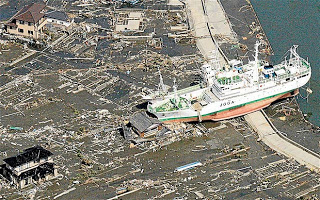Hundreds, thousands of people were being killed before my eyes, some in the most horrible way. And on that first day, like all journalists, I began writing about the disaster much as I had written about the 2004 earthquake and tsunamis which had devastated the coasts of the Indian Ocean.
But then something odd happened. When it became clear the waves had struck a nuclear power plant, Fukushima Dai-ichi, 100 or so miles north of Tokyo, it was almost as if the great disaster we had witnessed had been erased from view. Suddenly, all the reports concentrated on the possibility of a reactor meltdown, the overheating fuel rods, and the design flaws in this ancient plant.
Soon we journalists became versed in the terminology of nuclear disaster – sieverts and millisieverts, the difference between pressurised and boiling water reactors, the half-lives of various isotopes of caesium and iodine.
It was at this point, at around day three, that I realised that something had gone seriously wrong with the reporting of the biggest natural disaster to hit a major industrialised nation for a century. We had forgotten the real victims, the 20,000-and-counting Japanese people killed, in favour of a nuclear scare story.
Yesterday, together with the rationalist campaign group Sense About Science, I attempted to put the record straight at the annual meeting of the American Association for the Advancement of Science in Vancouver. We argued that not only was the global media’s reaction to the Tohoku earthquake skewed in favour of a nuclear “disaster” that never was, but that this reporting had profound economic and even environmental implications.
For example, weeks after the tsunamis struck, several nations including Germany, Italy and Switzerland announced that they were
re-examining their commitment to civil nuclear power. On March 15, the EU energy commissioner, Günther Oettinger, announced that the imminent meltdown of No4 reactor threatened an “apocalypse”. Six weeks later, the German Chancellor Angela Merkel, a physicist by training who should have known better, announced the complete closure of the German nuclear power programme.
All this happened amid mounting hysteria – and an information void. It wasn’t until several weeks later that the first considered scientific reports emerged from Japan, notably the report by Britain’s nuclear regulator, Mike Weightman, which made it clear that although outdated, riddled with design flaws and struck by geological forces that went way beyond the design brief, the Fukushima plant had survived remarkably intact.
There are bitter ironies in all of this. The panic caused a minor evacuation of Tokyo, which almost certainly resulted in more road deaths than will ever be attributable to radiation leaks. At one point, governments in Europe, including ours, were offering to fly expats home from places where the radiation levels were lower than the natural background count in Aberdeen or Cornwall.
As Wade Allison, emeritus professor of physics at Oxford University, says: “The reporting of Fukushima was guided by the Cold War reflex that matched radiation with fear and mortal danger. Reactors have been destroyed, but the radiation at Fukushima has caused no loss of life and is unlikely to do so, even in the next 50 years. The voices of science and common sense on which the future of mankind depends were drowned out and remain to be heard, even today. The result has been unnecessary suffering and great socio-economic damage.”
If you liked this article, please give it a quick review on ycombinator or StumbleUpon. Thanks

Brian Wang is a Futurist Thought Leader and a popular Science blogger with 1 million readers per month. His blog Nextbigfuture.com is ranked #1 Science News Blog. It covers many disruptive technology and trends including Space, Robotics, Artificial Intelligence, Medicine, Anti-aging Biotechnology, and Nanotechnology.
Known for identifying cutting edge technologies, he is currently a Co-Founder of a startup and fundraiser for high potential early-stage companies. He is the Head of Research for Allocations for deep technology investments and an Angel Investor at Space Angels.
A frequent speaker at corporations, he has been a TEDx speaker, a Singularity University speaker and guest at numerous interviews for radio and podcasts. He is open to public speaking and advising engagements.


